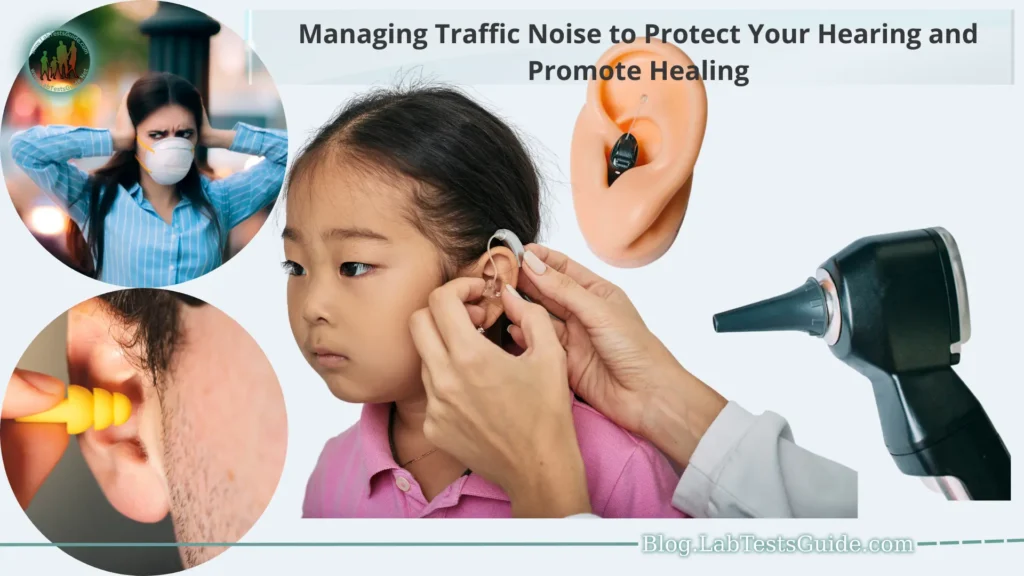Traffic noise is a type of environmental noise caused by various modes of transportation, including cars, buses, trucks, motorcycles, and airplanes. It is unwanted and harmful sound that can be persistent and intrusive, especially in urban areas. Traffic noise exposure over time has been linked to a variety of health problems, including hearing loss, sleep disturbances, hypertension, cardiovascular disease, and cognitive decline. Studies have shown that traffic noise can cause a physiological stress response in the body, which can lead to changes in blood pressure, heart rate, and hormone levels.

Understanding traffic noise:
Sources and types of traffic noise.
The most common types of traffic noise include.
- Continuous noise: This is the noise generated by the constant movement of traffic, such as the hum of a busy highway or the constant noise of a busy street.
- Impulsive noise: This is noise generated by sudden events, such as a car horn blaring or brake screeching.
- Low Frequency Noise: This is noise that has a lower frequency and can be felt more than it can be heard. Low frequency noise can be generated by large trucks or buses and can cause vibrations in buildings and homes.
- High Frequency Noise: This is noise that has a higher frequency and can be more piercing or shrill, like the sound of a motorcycle engine.
Health effects of exposure to traffic noise.
Some of the health effects of exposure to traffic noise include.
- Hearing Loss: Exposure to high noise levels can cause permanent hearing damage. Prolonged exposure to noise levels above 85 decibels can cause hearing loss.
- Sleep disturbances: Traffic noise can cause sleep disturbances, leading to daytime fatigue, impaired cognitive function, and reduced productivity. Sleep disturbance has also been linked to an increased risk of cardiovascular disease.
- High blood pressure: Exposure to traffic noise can increase blood pressure, which can lead to high blood pressure, a risk factor for heart disease and stroke.
- Cardiovascular disease: Exposure to traffic noise has been linked to an increased risk of cardiovascular disease, including heart attacks and strokes.
- Cognitive Impairment: Traffic noise can cause cognitive impairment, including memory loss, reduced attention span, and difficulty concentrating.
- Anxiety and Depression: Exposure to traffic noise can cause psychological distress, including anxiety and depression.
The effects of traffic noise on health can be influenced by factors such as duration of exposure, noise intensity and individual susceptibility. Children, the elderly, and people with pre-existing health conditions are particularly vulnerable to the health effects of traffic noise.
Prevention of hearing loss from traffic noise:
Understanding safe noise levels.
Understanding safe noise levels is important to prevent hearing damage and mitigate the health effects of noise exposure. The safe level of noise exposure depends on the intensity of the noise and the duration of the exposure.
To protect hearing and prevent health effects from noise exposure, it is important to use hearing protection devices, such as earplugs or earmuffs, when in noisy environments. It is also important to take breaks from noisy environments and limit the duration of exposure to noisy environments.
In general, understanding safe noise levels is an important step in preventing noise-induced hearing loss and mitigating the health effects of noise exposure.
Using ear protection.
The use of hearing protection is an effective way to prevent noise-induced hearing loss and reduce the impact of noise exposure on health. Hearing protection devices include earplugs and earmuffs, which work by reducing the intensity of sound reaching the inner ear.
- Earplugs, are small disposable or reusable devices that are inserted into the ear canal. They come in various shapes and sizes, and some are designed to fit in the ear canal. Earplugs can reduce noise levels by between 15 and 30 decibels, depending on the type and fit.
- Earmuffs ,are larger over-the-ear devices that cover the entire outer ear and seal against the head. They can reduce noise levels by between 15 and 30 decibels, depending on type and fit. The earmuffs are reusable and can be adjusted to fit different head sizes.
When wearing hearing protection, it is important to ensure a proper fit to maximize effectiveness. Earplugs should be inserted deep enough into the ear canal to form a tight seal, while ear muffs should fit snugly against the head. It is also important to constantly wear hearing protection in noisy environments and to follow the manufacturer’s instructions for proper use and maintenance.
In general, the use of hearing protection is a simple and effective way to prevent noise-induced hearing loss and mitigate the health effects of noise exposure. By reducing the intensity of sound reaching the inner ear, hearing protection can help protect hearing and reduce the impact of noise on overall health.
Maintaining a healthy lifestyle.
By maintaining a healthy lifestyle, people can improve their overall health and reduce the health impact of noise exposure. This can help mitigate the adverse health effects of traffic noise and promote general wellbeing.
Diagnosis of hearing loss:
The diagnosis of hearing loss usually involves a combination of a hearing test and a medical evaluation.
- Hearing test: A hearing test, also called an audiogram, is used to measure a person’s ability to hear sounds of different frequencies and loudnesses. The test is usually done in a soundproof room and involves listening to tones through headphones or speakers and responding when the tone is heard. The test results are represented on an audiogram, which shows the degree and type of hearing loss.
- Medical evaluation: A medical evaluation is usually done by an ear, nose, and throat (ENT) specialist or an audiologist. The evaluation may include a physical examination of the ear to check for abnormalities or damage, as well as a review of your medical history and any medications that may affect hearing.
In some cases, additional tests may be necessary to determine the cause and severity of the hearing loss. These may include
- Speech Audiometry: A test that measures a person’s ability to hear and repeat words at different volumes.
- Tympanometry: A test that measures the movement of the eardrum in response to changes in air pressure.
- Otoacoustic emissions (OAE) test: a test that measures the sounds produced by the inner ear in response to sound stimulation.
- Auditory Brainstem Response (ABR) Test: A test that measures electrical activity in the brain in response to sound stimulation.
Once a diagnosis of hearing loss is made, treatment options may include hearing aids, cochlear implants, or other assistive devices, as well as communication strategies and lifestyle modifications to improve hearing and quality of life.
Evaluation of symptoms:
Here are some common symptoms of hearing loss that may indicate the need for evaluation.
- Difficulty understanding speech: If you have difficulty understanding speech, especially in noisy environments or when multiple people are speaking, this may be a sign of hearing loss.
- Asking others to repeat it: If you frequently ask others to repeat it, this may indicate that you have difficulty listening.
- Turn up the volume : If you find yourself turning up the volume on the television or radio, this may be a sign of hearing loss.
- Ringing or ringing in the ears: If you experience ringing or ringing in your ears, this may be a sign of tinnitus, which is often associated with hearing loss.
- Feeling like others are mumbling: If you feel others are mumbling or not speaking clearly, this may be a sign of hearing loss.
- Withdrawal from social situations: If you avoid social situations or withdraw from conversations due to difficulty hearing, this may be a sign of hearing loss.
If you experience any of these symptoms, it is important to see a medical professional for evaluation. A hearing test and medical evaluation can help determine the cause and severity of hearing loss and guide appropriate treatment options.
Treatment of hearing loss:
Here are some common treatments for hearing loss.
- Hearing Aids: Hearing aids are small electronic devices that amplify sound and improve hearing. They come in various types and styles, and can be customized to suit individual needs. Hearing aids can be very effective in improving listening and communication skills.
- Cochlear Implants: Cochlear implants are small electronic devices that are surgically implanted in the ear and stimulate the auditory nerve to send sound signals to the brain. They are typically used for severe to profound hearing loss that cannot be treated with hearing aids.
- Assistive Listening Devices: Assistive listening devices are devices used to amplify sound in specific situations, such as in noisy environments or during telephone conversations. Examples include FM systems, captioned telephones, and personal sound amplifiers.
- Communication Strategies: Communication strategies can help improve communication skills in people with hearing loss. These may include techniques such as face-to-face communication, speaking clearly and slowly, and using visual cues.
- Lifestyle Modifications: Lifestyle modifications, such as avoiding loud noises and taking care of your general health, can help prevent further hearing damage and improve general well-being.
It is important to consult with a medical professional to determine the best treatment options for hearing loss. Early diagnosis and treatment can help prevent further hearing loss and improve quality of life.
Mitigating traffic noise:
There are several ways to mitigate traffic noise, including.
- Use of acoustic barriers: Acoustic barriers are structures designed to block or reduce the transmission of noise. They can be made of various materials, such as concrete, metal, or vegetation, and can be placed between the source of the noise and the receiver.
- Roadway design modifications: Roadway design modifications can help reduce traffic noise. For example, the use of low-noise pavement or lowering the speed limit can help reduce noise levels.
- Traffic management strategies: Strategies such as reducing traffic volume or restricting the types of vehicles that can use certain roads can help reduce traffic noise.
- Using Vegetation: Vegetation, such as trees and shrubs, can help absorb and deflect sound waves, reducing the amount of noise reaching the receiver.
- Building design modifications: Building design modifications, such as the use of sound-insulating materials, double-glazed windows, and sealing gaps and cracks, can help reduce the amount of noise entering a building.
- Use of noise canceling earplugs or headphones: Noise canceling earplugs or headphones can be used to block or reduce the amount of noise reaching the ear.
It is important to note that the most effective way to mitigate traffic noise is through a combination of strategies. A comprehensive approach that includes multiple strategies can help achieve the greatest reduction in noise levels.
Future of traffic noise reduction and hearing health:
Some potential developments in traffic noise reduction include.
- Intelligent Traffic Management Systems: These systems use sensors, cameras, and artificial intelligence to manage traffic flow, reduce congestion, and optimize routing. This can lead to a reduction in traffic volume and noise levels.
- Quieter transportation options: The development of quieter electric vehicles and public transportation systems can help reduce noise levels on highways and in cities.
- Innovative materials and designs: The use of new materials and designs for noise barriers, building facades and road surfaces can help reduce noise transmission.
- In terms of hearing health, ongoing research is leading to new advances in the prevention and treatment of hearing loss. For example, gene therapy and stem cell research are showing promising results in regenerating hair cells in the inner ear, which may improve hearing.
In addition, the use of teleaudiology and remote hearing aid programming makes it easier for people to receive hearing care and support, regardless of their location.
In general, as technology and research advance, there is great potential for further improvements in traffic noise reduction and the prevention and treatment of hearing loss.
FAQs
1. What is traffic noise, and why is it a concern for hearing health?
Traffic noise refers to the sounds generated by vehicles on roads and highways. It can be a concern for hearing health because prolonged exposure to high levels of traffic noise can lead to hearing damage and other health issues.
2. How does traffic noise affect hearing?
Traffic noise can cause noise-induced hearing loss (NIHL) by damaging the delicate hair cells in the inner ear. It can also contribute to stress, sleep disturbances, and increased risk of cardiovascular problems.
3. What are the early signs of hearing damage from traffic noise?
Early signs may include difficulty hearing conversations, ringing in the ears (tinnitus), and increased sensitivity to loud sounds.
4. When should I seek professional help for hearing problems related to traffic noise exposure?
If you notice any changes in your hearing or experience persistent symptoms like tinnitus, consult an audiologist or ear specialist for a comprehensive evaluation.
5. What types of ear protection are effective against traffic noise?
Earplugs and earmuffs specifically designed for noise reduction can effectively protect your ears from traffic noise. Look for products with a high noise reduction rating (NRR).
6. How can I choose the right ear protection for my needs?
Consider factors like NRR, comfort, and fit. Custom-molded earplugs are an option for those seeking a personalized fit and maximum noise reduction.
7. Are there ways to reduce traffic noise in my environment?
Yes, you can reduce traffic noise by using noise barriers, soundproofing windows and doors, and incorporating noise-reducing landscaping, such as planting trees and bushes.
8. Can a healthy lifestyle help protect against the effects of traffic noise on hearing?
Yes, maintaining a healthy lifestyle with a balanced diet, regular exercise, and stress management can support overall hearing health and help mitigate the impact of noise.
9. What are some practical tips for promoting healing if my hearing has been affected by traffic noise?
If hearing damage has occurred, follow your healthcare provider’s recommendations. Additionally, consider assistive hearing devices, such as hearing aids, and continue practicing hearing protection to prevent further damage.
Conclusion:
In conclusion, traffic noise can have significant negative impacts on our health, particularly our hearing. Exposure to high levels of traffic noise can cause hearing loss, tinnitus, and other health problems. However, there are several ways to mitigate traffic noise, including the use of noise barriers, roadway design modifications, traffic management strategies, and building design modifications. Also, taking steps to protect our hearing, such as wearing hearing protection and maintaining a healthy lifestyle, can help prevent hearing loss.
The future of traffic noise reduction and hearing health is bright, with technological advances and ongoing research leading to new developments in these areas. With a comprehensive approach that includes multiple strategies, we can work to reduce traffic noise levels and improve hearing health, ultimately leading to a healthier and more enjoyable living environment for all.






